For more than 400 years, the Roman Empire had a profound influence in Britain. The Romans called the British Isles ‘Britannia’. The actual occupation lasted from 43 AD to 410 AD, although the Romans first entered Britannia in 55 BC under the leadership of Julius Caesar. He crossed the channel and landed his forces in Kent. The ancient Britons fought valiantly and Caesar was forced to retreat and spend the winter in Gaul, (France). He returned in 54 BC with five Roman legions, (around 30,000 soldiers) They marched across Kent and eventually crossed the River Thames. Caesar was successful in forcing some of the barbarian tribes of Britannia to pay tribute to the Romans in return for peace, but he didn’t actually conquer the lands.
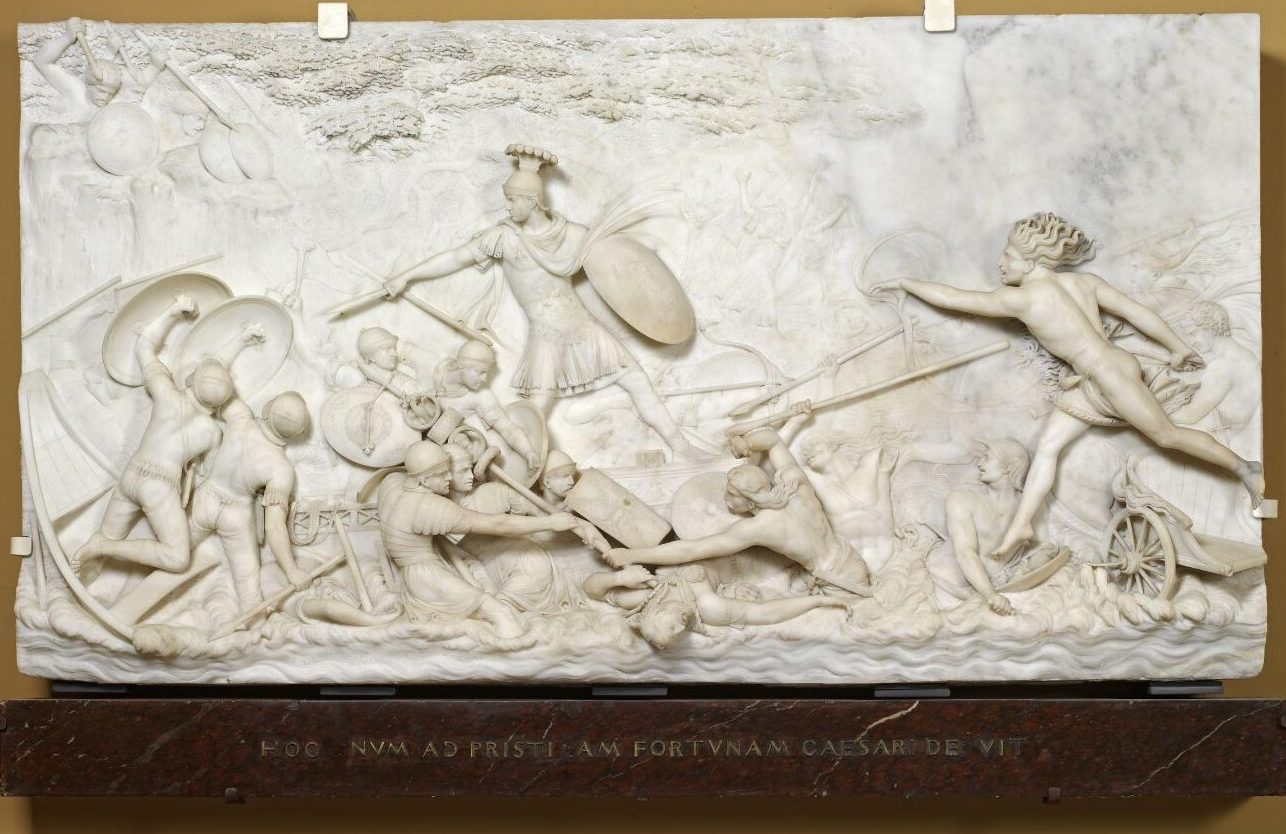 John Deare’s marble relief of Caesar’s invasion of Britain, on display at the V&A, London
John Deare’s marble relief of Caesar’s invasion of Britain, on display at the V&A, London
Emperor Claudius wanted to gain more power, by controlling more lands. In 43 AD he sent his trusted general, Plautius, with four legions of Roman soldiers, to conquer Britain and once again, the barbarian tribes of Britannia fought back. The Romans managed to defeat the Catuvellauni, (the most powerful Belgic tribe in ancient Britain) and then began organising their conquests, progressing north and west. By 47 AD, the Romans held all the lands southeast of the Fosse Way.
In 60-61 AD, an armed uprising by native Celtic Britons took place, led by Boudica, the Queen of the Iceni tribe, (who were based in present day Norfolk). The uprising was motivated by the Romans’ failure to honour an agreement they had made with Boudica’s husband, Prasutagus, regarding the succession of his kingdom after his death.
Boudica led an army to Camulodunum, (Colchester) and burnt it to the ground. The city had been made into a ‘colonia’ for Roman military veterans. These veterans had been accused of mistreating the locals. A temple had been erected to Claudius, (a former emperor) in the city, at great expense to the local population, which also caused much resentment. Boudica’s forces then went on to destroy Londinium, (London) which, since 43 AD, had grown into a thriving commercial centre, containing a large population of traders and Roman officials. She then led her army north, to Verulamium, (St Albans).
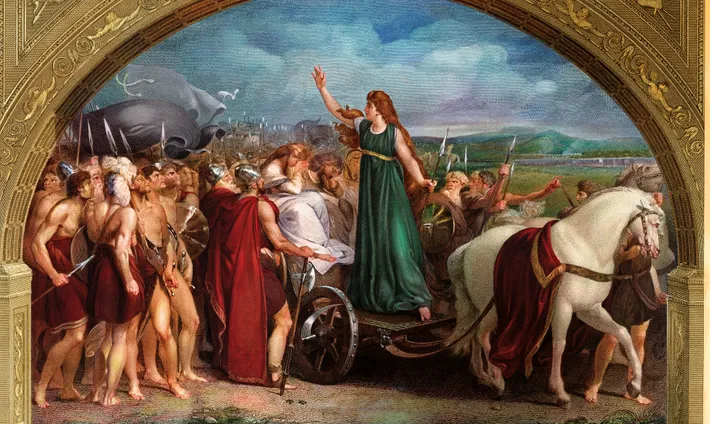 Print by William Sharp, from the engraving by Thomas Stothard, displayed at the National Portrait Gallery, London
Print by William Sharp, from the engraving by Thomas Stothard, displayed at the National Portrait Gallery, London
Around 61 AD, Gaius Suetonius Paulinus, the conqueror of Mauretania, (modern day Algeria and Morocco), became the governor of Britain. After conquering Wales and ultimately the island of Mona, he marched towards Verulamium, (St Albans) for what would be the final battle against Boudica and her army of rebels. Paulinus only had two legions available to him, (12,000 men) The Britons outnumbered the Roman forces by twenty to one. Although the Britons were gathered in considerable force, (more than 230,000) the Iceni and other tribes had been disarmed some years before and it is thought they may have been poorly equipped for battle.
The Roman army was well-trained, well-armed, highly skilled and heavily protected. Native Britons were skilled at riding two-wheeled battle chariots and using spears, but they wore very little armour. Paulinus chose to engage the Britons in a defile, (a narrow gorge) with a wood behind. The defile opened out into a wide plain in front of his legionnaires. The walls of the gorge protected the Romans from surprise attacks and the forest behind prevented Boudica from deploying chariots and attacking from the rear. Paulinus defeated the rebels in the ‘Battle of Watling Street’. Boudica died soon afterwards. Tacitus, (a well-respected Roman historian and politician) states that 80,000 Britons fell that day, with the loss of only 400 Romans.
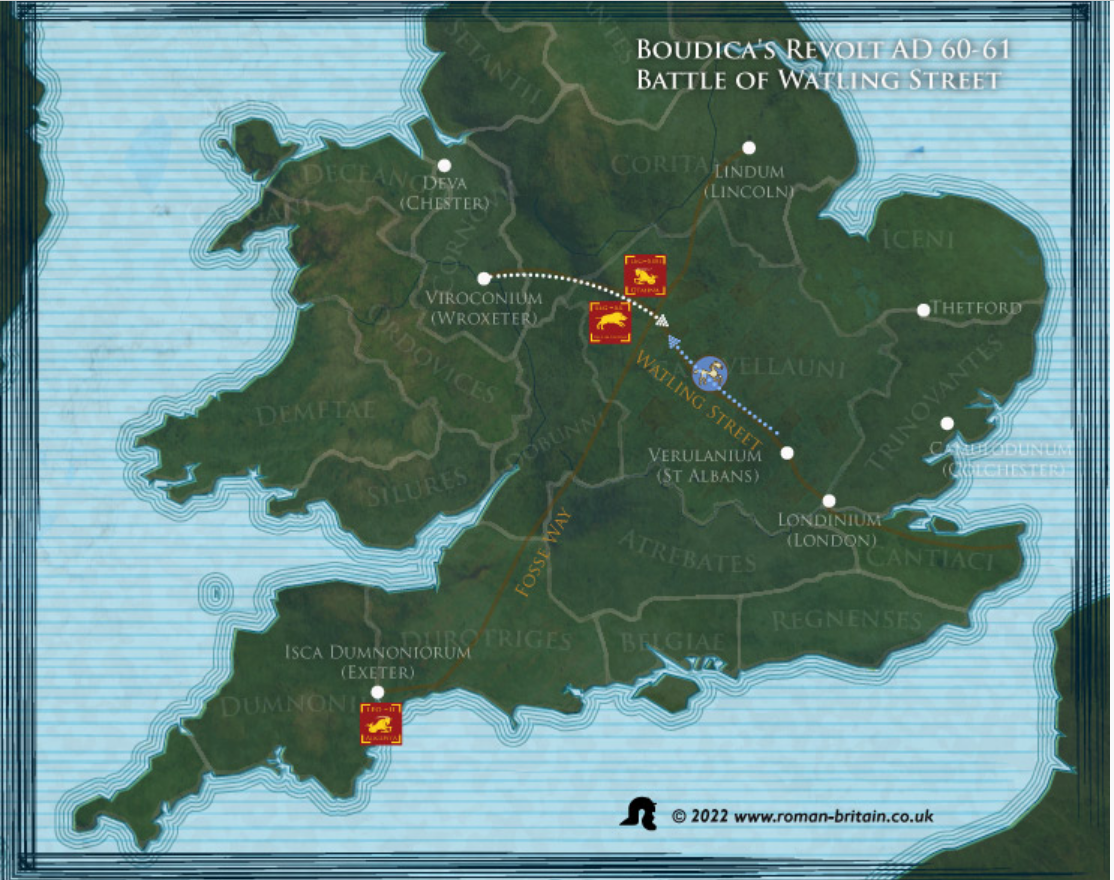
10 things you might not know about Roman Britain
1. Roman cruelty was the cause of the rebellion in Britannia. Prasutagus, (the king of the Iceni tribe), thought he had secured independence for his people, by leaving his lands jointly to his daughters and also to the Roman emperor, Nero. However, when he died in AD 61 his will was ignored. The Romans seized his lands and violently humiliated his family: his widow Boudica was publicly flogged and her two daughters brutally raped.
2. The island of Mona, (Anglesey) off the northwest coast of Wales, was a refuge for British rebels and a stronghold of the druid community. It was regarded as the spiritual centre of Britannia. Druids had a variety of functions outside of the temple. They were teachers, scientists, philosophers, and judges in equal measure. Druids were the arbiters of the British justice system at that time. The Roman emperor Nero knew that if he killed the druids on Mona, then the native population would capitulate.
3. The tribes of Picts in Caledonia, (Scotland) were violent warriors and they were able to resist Roman invasion. In 122 AD, the Roman Emperor Hadrian decided to build a wall across the middle of Britain, in order to keep the Pics out of Britannia. This structure helped defend the new lands of the Roman Empire from the barbarians in Caledonia. When Hadrian’s Wall was completed it spanned 73 miles, (the entire width of the land, from Wallsend on the River Tyne, in the east, to Bowness-on-Solway in the west) and fluctuated in height, from 3 to 6 metres, along the entire length. The structure was 3 to 6 metres wide, with a deep, ditch-like construction, called a vallum, running immediately south of the wall. Soldiers were garrisoned along the line of the wall in large forts, smaller milecastles and intervening turrets. The remains of the wall are now part of the ‘UNESCO Transnational World Heritage Site Frontiers of the Roman Empire’.
4. In 410 AD, the majority of the Roman troops were forced to leave Britannia in order to defend their capital city against various barbarian tribes. The Goths and Vandals sacked the city of Rome twice in the 5th century, (in 410 and 455) As the Roman Empire declined in power, the Western Roman Empire collapsed in 476.
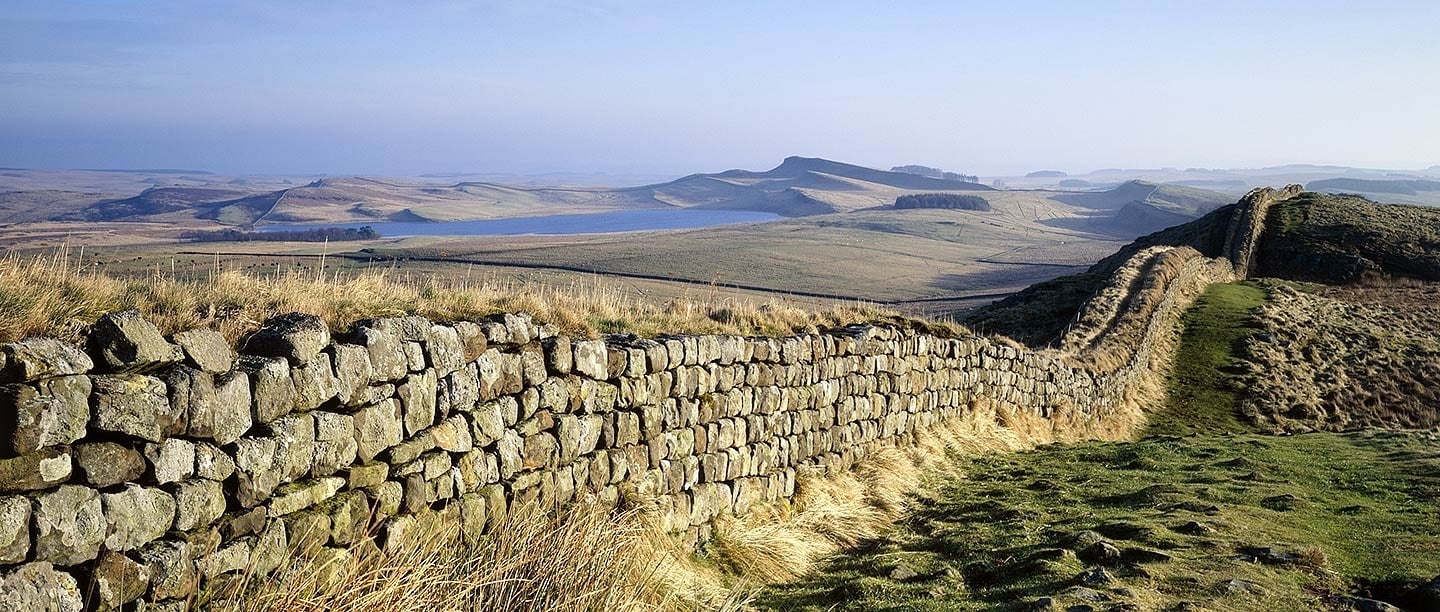 Hadrian’s Wall
Hadrian’s Wall
5. The Roman legacy in Britannia is considerable. The Romans were master builders and had advanced engineering skills, which allowed them to build technologically advanced walls, roads and aqueducts, to transport water. They also introduced concrete to the islands. They built many miles of roads in Britannia, (around 55,000 miles). Some of these roads are still in use today, such as the A1 from York, (Eboracum).
6. They left behind a rich and sophisticated Roman culture, in the form of government systems, laws, the Latin language and the Julian calendar. The Julian calendar was the first to consist of 365 days, (with a leap year every four years). July and August were named after the early rulers Julius Caesar and Emperor Augustus. This calendar forms the basis of the Gregorian calendar that we use today.
7. The Romans left an advanced system of currency in Britain. Some of the tribes in the South of England produced coins before the Romans arrived, however, they were not used for purchasing things. The Romans brought in their own coinage, which was the same across the Empire. A denarius minted in Rome could be spent in Britain, North Africa or Turkey.
8. Bathing was an extremely important part of Roman life. Going to the baths was a social event. Baths were also places for exercise, gambling and catching up on the gossip. They usually contained hot rooms, both dry and wet, cold plunge pools and warm baths. The city of Aqua Sulis, (Bath) was named after the elaborate Roman baths built there. Although the Romans didn’t have central heating, they did have ways (other than fireplaces) to keep buildings warm. Raised floors, laid on squat columns, allowed hot air to circulate. Fires would be lit in stoke-holes, which allowed hot air to circulate and so the Romans brought the concept of underfloor heating to Britain as well.
9. The Romans introduced street stalls, selling food. With more than 10,000 soldiers in Britain, based at forts such as Birdoswald, having access to convenient food in towns and cities was vitally important and vendors serving fast food would have been commonplace. The Romans also introduced some staple foods, such as apples, pears and peas to Britain.
10. In ‘Life of Brian’ the infamous Monty Python film, John Cleese, playing Reg, (the leader of the revolutionary group ‘The People’s Front of Judea’) says: “All right, but apart from the sanitation, the medicine, education, wine, public order, irrigation, roads, a fresh water system and public health, what have the Romans ever done for us?” That just about sums up the influence of the Roman Empire on Britain.
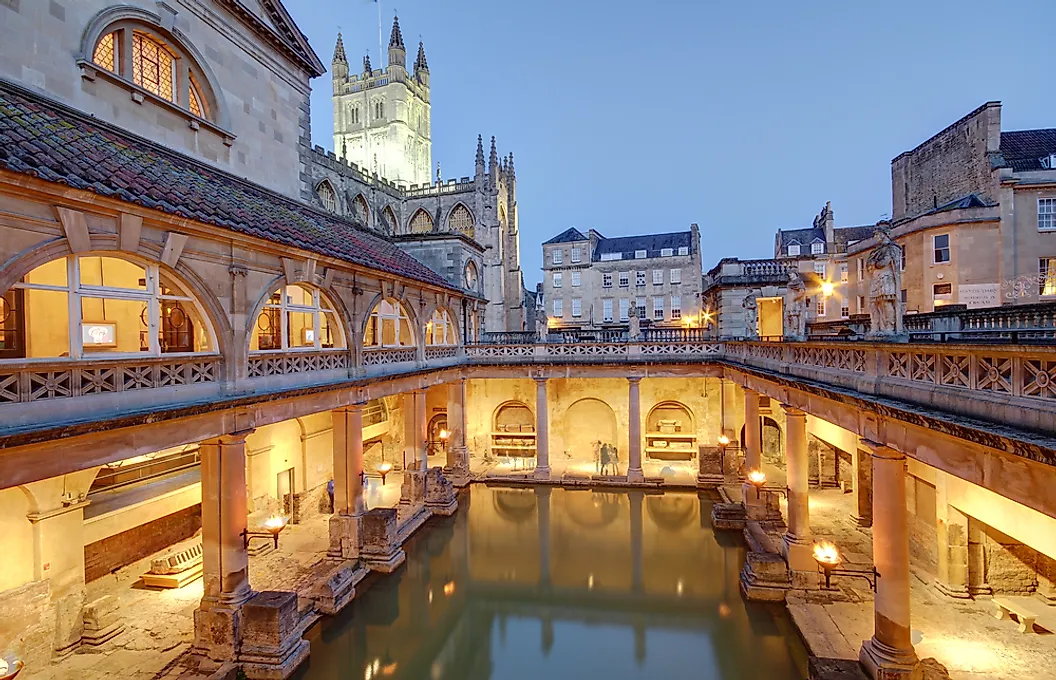 Roman Baths in Bath, UK
Roman Baths in Bath, UK
Following the Roman retreat, Britain plunged into a period known as the ‘Dark Ages’. The 5th and 6th centuries are wrapped in obscurity. Records are few, difficult to interpret, propagandist, or written long after the events they describe. After 350 years of Roman rule, all Britons were, in a sense, Romans. However, Britain was no longer protected by an imperial power, so these people were vulnerable to attack. At first, the chief enemies of an independent Britain were Irish raiders from the west and Picts from the north. Later, Angles, Saxons and Jutes arrived from across the North Sea.
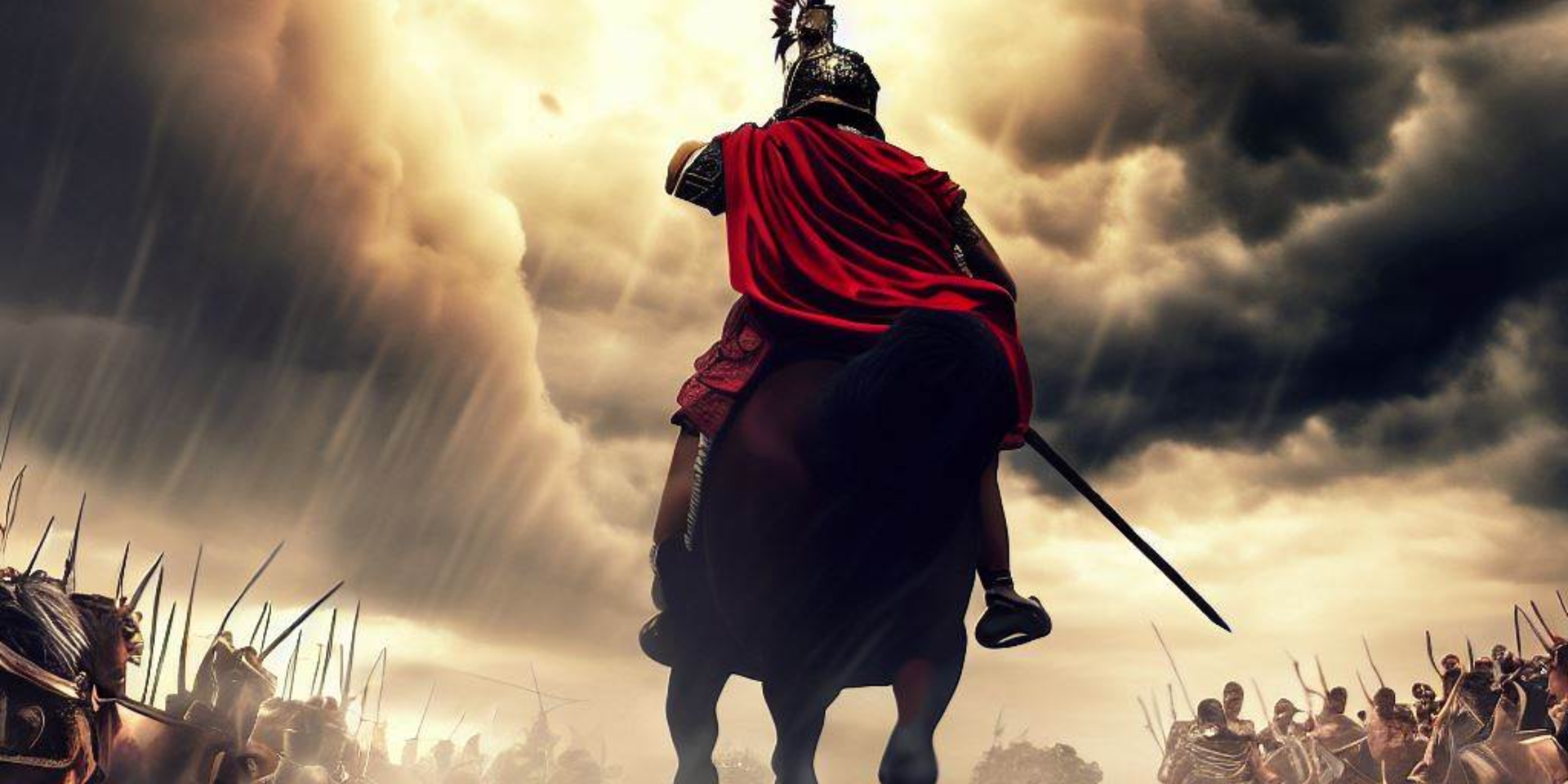 Photo credit, History Skills
Photo credit, History Skills